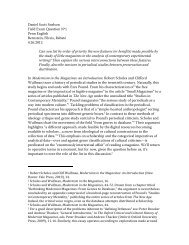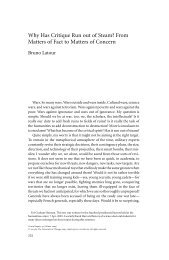The Exploit: A Theory of Networks - asounder
The Exploit: A Theory of Networks - asounder
The Exploit: A Theory of Networks - asounder
You also want an ePaper? Increase the reach of your titles
YUMPU automatically turns print PDFs into web optimized ePapers that Google loves.
168 Notes<br />
social levels. <strong>The</strong> United States and its allies probably hold only marginal<br />
advantages at the narrative and technological levels.”<br />
8. Clay Shirky, “Power Laws, Weblogs, and Inequality,” http: // www<br />
.shirky.com/ writings/ powerlaw_weblog.html (accessed June 11, 2005).<br />
9. Gilles Deleuze, Negotiations, trans. Martin Joughin (Minneapolis:<br />
University <strong>of</strong> Minnesota Press, 1990), 178.<br />
Nodes<br />
1. John Arquilla and David Ronfeldt, <strong>Networks</strong> and Netwars: <strong>The</strong> Future<br />
<strong>of</strong> Terror, Crime, and Militancy (Santa Monica: Rand, 2001), 6. A similar<br />
litany from 1996 reads: “Netwar is about Hamas more than the PLO, Mexico’s<br />
Zapatistas more than Cuba’s Fidelistas, the Christian Identity Movement<br />
more than the Ku Klux Klan, the Asian Triads more than the Sicilian<br />
Mafia, and Chicago’s Gangsta Disciples more than the Al Capone Gang.”<br />
See John Arquilla and David Ronfeldt, <strong>The</strong> Advent <strong>of</strong> Netwar (Santa Monica:<br />
Rand, 1996), 5. Arquilla and Ronfeldt coined the term “netwar,” which<br />
they define as “an emerging mode <strong>of</strong> conflict (and crime) at societal levels,<br />
short <strong>of</strong> traditional military warfare, in which the protagonists use network<br />
forms <strong>of</strong> organization and related doctrines, strategies, and technologies attuned<br />
to the information age.” Arquilla and Ronfeldt, <strong>Networks</strong> and Netwars,<br />
6.<br />
2. Mark Wigley, “Network Fever,” Grey Room 4 (2001).<br />
3. <strong>The</strong> largest and most important publication series for Internet protocols<br />
is called “Request for Comments” (RFC). A few thousand RFC documents<br />
have been drafted to date. <strong>The</strong>y are researched, published, and maintained<br />
by the Internet Engineering Task Force (IETF) and related<br />
organizations.<br />
4. If this section seems overly brief, it is because we have already devoted<br />
some attention in other publications to the definition <strong>of</strong> the concept.<br />
See in particular Eugene Thacker, Biomedia (Minneapolis: University <strong>of</strong> Minnesota<br />
Press, 2004); and Alexander Galloway, Protocol (Cambridge: MIT<br />
Press, 2004).<br />
5. Overviews <strong>of</strong> graph theory are contained in any college - level discrete<br />
mathematics textbook. See also Gary Chartrand, Introductory Graph<br />
<strong>The</strong>ory (New York: Dover, 1977). For a historical overview, see Norman<br />
Biggs et al., Graph <strong>The</strong>ory, 1736– 1936 (Oxford: Clarendon, 1976). Graph<br />
theory principles are commonly used in communications and network routing<br />
problems, as well as in urban planning (road and subway systems), industrial<br />
engineering (workflow in a factory), molecular biology (proteomics),<br />
and Internet search engines.<br />
6. See Paul Baran, On Distributed Communications (Santa Monica:<br />
Rand, 1964).









